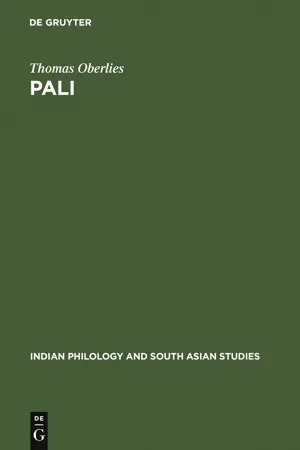
eBook - PDF
Pali
A Grammar of the Language of the Theravada Tipitaka. With a Concordance to Pischel's Grammatik der Prakrit-Sprachen
- 403 pages
- English
- PDF
- Available on iOS & Android
eBook - PDF
Pali
A Grammar of the Language of the Theravada Tipitaka. With a Concordance to Pischel's Grammatik der Prakrit-Sprachen
About this book
The grammar presents a full decription of Pali, the language used in the Theravada Buddhist canon, which is still alive in Ceylon and South-East Asia. The development of its phonological and morphological systems is traced in detail from Old Indic. Comprehensive references to comparable features and phenomena from other Middle Indic languages mean that this grammar can also be used to study the literature of Jainism.
Frequently asked questions
Yes, you can cancel anytime from the Subscription tab in your account settings on the Perlego website. Your subscription will stay active until the end of your current billing period. Learn how to cancel your subscription.
At the moment all of our mobile-responsive ePub books are available to download via the app. Most of our PDFs are also available to download and we're working on making the final remaining ones downloadable now. Learn more here.
Perlego offers two plans: Essential and Complete
- Essential is ideal for learners and professionals who enjoy exploring a wide range of subjects. Access the Essential Library with 800,000+ trusted titles and best-sellers across business, personal growth, and the humanities. Includes unlimited reading time and Standard Read Aloud voice.
- Complete: Perfect for advanced learners and researchers needing full, unrestricted access. Unlock 1.4M+ books across hundreds of subjects, including academic and specialized titles. The Complete Plan also includes advanced features like Premium Read Aloud and Research Assistant.
We are an online textbook subscription service, where you can get access to an entire online library for less than the price of a single book per month. With over 1 million books across 1000+ topics, we’ve got you covered! Learn more here.
Look out for the read-aloud symbol on your next book to see if you can listen to it. The read-aloud tool reads text aloud for you, highlighting the text as it is being read. You can pause it, speed it up and slow it down. Learn more here.
Yes! You can use the Perlego app on both iOS or Android devices to read anytime, anywhere — even offline. Perfect for commutes or when you’re on the go.
Please note we cannot support devices running on iOS 13 and Android 7 or earlier. Learn more about using the app.
Please note we cannot support devices running on iOS 13 and Android 7 or earlier. Learn more about using the app.
Yes, you can access Pali by Thomas Oberlies in PDF and/or ePUB format, as well as other popular books in Languages & Linguistics & Languages. We have over one million books available in our catalogue for you to explore.
Information
Table of contents
- 1. Introduction
- § 1. Pāli and the Indo-Aryan languages
- § 2. The orthography of the Pāli texts
- 2. Phonology
- 2.1. Vowel quantity, word finals and word rhythm
- § 3. The ‘law of mora’
- § 4. Word-finals and word rhythm
- 2.2. The vowels
- § 5. The vowel a
- § 6. The vowel ā
- § 7. The vowel i
- § 8. The vowel ῑ
- § 9. The vowel u
- § 10. The vowel ū
- § 11. The vowel e
- § 12. The vowel ο
- 2.3. The consonants
- § 13. The consonant system
- § 14. Consonantal sound change
- § 15. Development of ΟΙΑ word-initial consonants
- § 16. Assimilation of clusters of two (ΟΙΑ) consonants
- § 17. Assimilation of clusters of three (ΟΙΑ) consonants
- § 18. Peculiar assimilation of (ΟΙΑ) consonant clusters
- § 19. Deaspiration of (Pāli) CCh-clusters
- § 20. Assimilation of clusters at the boundary of compounds
- § 21. Assimilation and splitting-up of consonant clusters
- § 22. Irregular sound changes
- 2.4. Sandhi
- § 23. Vocalic sandhi
- § 24. Consonantal sandhi
- § 25. Bridging of hiatus
- § 26. Lengthening of -aṃ before an enclitic
- § 27. Dropping of initial vowels (in sandhi)
- 3. Morphology
- 3.1. The noun
- § 28. Introduction
- § 29. Paradigms
- § 30. a-inflexion
- § 31. ā-inflexion
- § 32. i/u-inflexion
- § 33. Inflexion of sakhi- ‘friend’
- § 34. i(n)- / mi(n)- / vi(n)-inflexion
- § 35. Inflexion of nomina verbalia in °ū-
- § 36. ī/ū-inflexion
- § 37. Inflexion of diphthong-stems
- § 38. Inflexion of root-nouns and consonantal stems
- § 39. n-inflexion
- § 40. a(r)-inflexion
- § 41. ma(nt)-/ va(nt)-/-a(nt)-inflexion
- 3.2. The pronouns
- § 42.1 Inflexion of the personal pronoun: 1st and 2nd person
- 3.3. The numerals
- § 43.1. The cardinals
- 3.4. The verb
- § 44. The verb system
- § 45. ‘Root’- and e-present
- § 46. The verbal endings
- § 47. The optative
- § 48. The preterite
- § 49. The future
- § 50. The conditional
- § 51. The denominative
- § 52. The causative
- § 53. The passive
- 3.5. The verbum infinitum
- § 54. The present / future participle
- § 55. The gerundive
- § 56. The verbal adjective
- § 57. The infinitive
- § 58. The absolutive
- 4. Literature
- 5. Abbreviations and sigla
- 6. Indices and concordances
- 6.1. Index rerum
- 6.2. Index verborum
- 6.3. Index locorum
- 6.4. Concordance to GEIGER’s and VON HINÜBER’s grammars
- 6.5. Concordance to PlSCHEL’s grammar